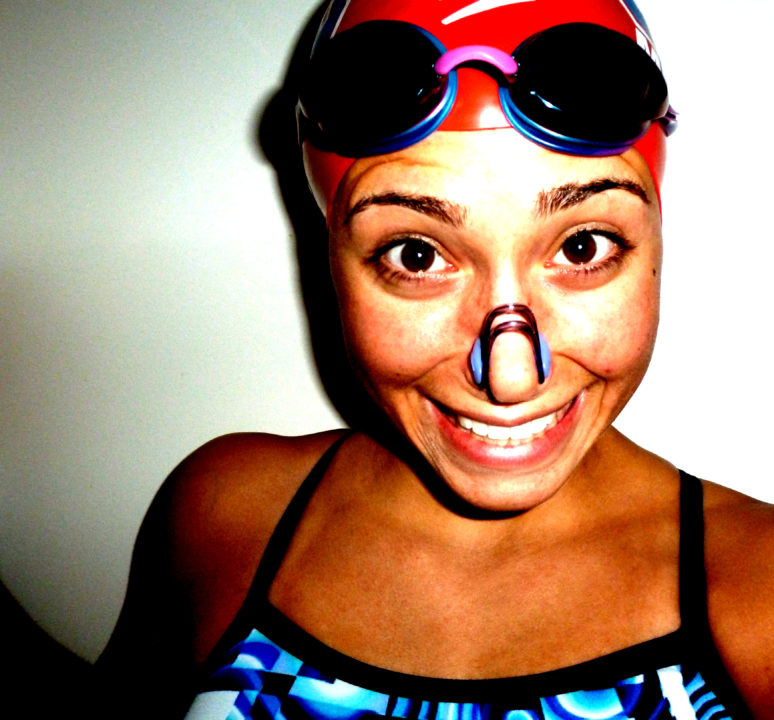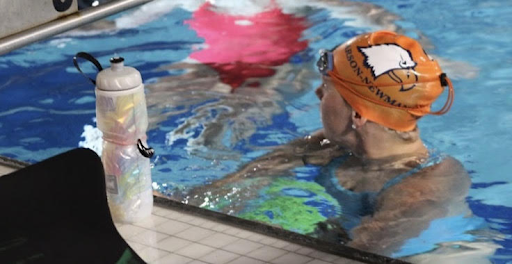You know those people who have amazing backstroke underwaters? The ones who can plug up their nose with their top lip and make it to the 15 nearly every single lap? Yeah I was not one of those people. You might remember that I was quite a terrible kicker, and backstroke underwaters were no exception to that. In high school when I realized that some people had this innate ability to plug up their nose during underwaters (man I’m so jealous of those people) and that I could not contort my face to do that, I did what anyone would do… I grabbed a nose clip. Nose clips are essentially the smallest piece of swim equipment you will routinely use and easy to lose because of it. So, after 6ish years or so of using one, I got pretty good at keeping up with mine. Here are a few tricks to make sure you never have to worry about not having your nose clip handy again:

Beata Nelson (photo: Jack Spitser)
The Fishhook: This is a classic nose clip look. You simply hook your nose clip to the side of your mouth so it resembles a fishhook. You can walk to the block with it on your mouth, you can swim your warm-down with it on your mouth, heck you could even keep it there during an entire practice if you want! When you do this, you always know exactly where your nose clip is, and it is so easy to move it up two inches to your nose if you need to do some backstroke. I’m not totally sure how sanitary this can be, but hey, it works.
Stuck to your suit: This is probably the second most common method a swimmer will utilize to keep up with their nose clip. For girls, this usually means the nose clip is hooked to the strap of their suit, and boys will usually hook the nose clip to the waistband of their suit. This is very useful for walking around on the pool deck. You know you have your nose clip handy, but you don’t have to have it on your mouth. I’m sure people do this all the time, but I was always hesitant to swim warm-up with it hooked to my suit because I was worried it would fall off. That is a risk some people are willing to take.
Hooked to your water bottle: When I didn’t have my nose clip fish hooked to my mouth, this was my technique of choice when toting it around. Since I was primarily doing freestyle at practice, I didn’t need my nose clip literally hooked to me at all times, but I still wanted it within reach if I did need it. So, I had a hair tie stuck around my water bottle and kept my nose clip attached to that hair tie. This was nice because it was always within reach and I didn’t have to worry about it getting lost. 10/10 would recommend doing this.
Designated spot in bag: Do not, and I repeat, do not just drop your nose clip in your bag. Whether you want to keep it in your mesh bag or your swim bag, make sure you have a designated spot for it. Mesh bags can have little openings and rips that are just asking for a nose clip to fall through. A swim bag can be a blackhole. You drop your nose clip into it willy nilly and you may never find it again.
Hooked on a Feeling: Wait, what’s this doing here? This isn’t a way to keep up with your nose clip, this is just a catchy song.
These are just a few of the most common ways I’ve seen people keep track of their nose clips. If you have another way to keep track of yours, drop ‘em below in the comments, I want to know! And if you are one of those people that can plug your nose with your top lip, 1. I’m impressed you read this whole thing, and 2. Wow I wish I were you.



Thanks for writing this article. I’ve been looking for ways to keep up with a clip at practice when not actively wearing it.
I like to hook my nose clip to my goggle straps, It stays put and doesn’t get in the way